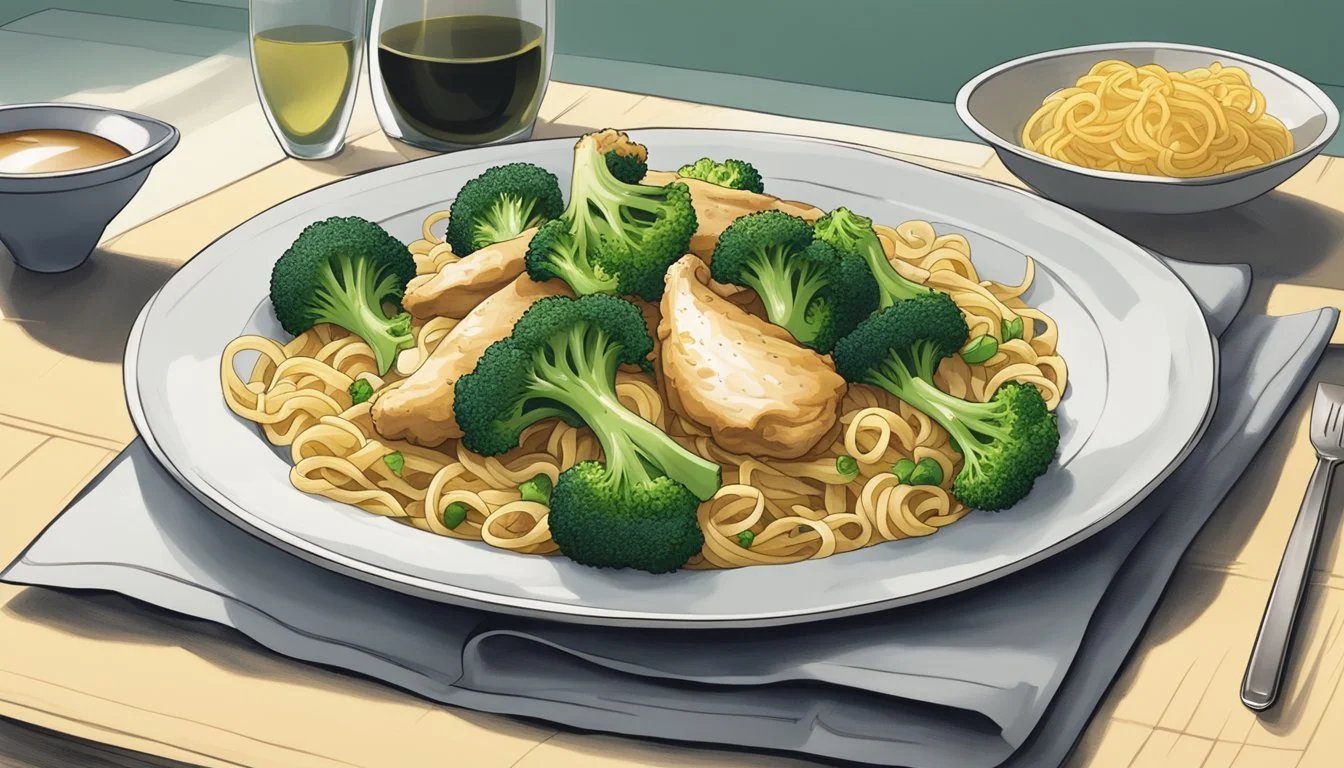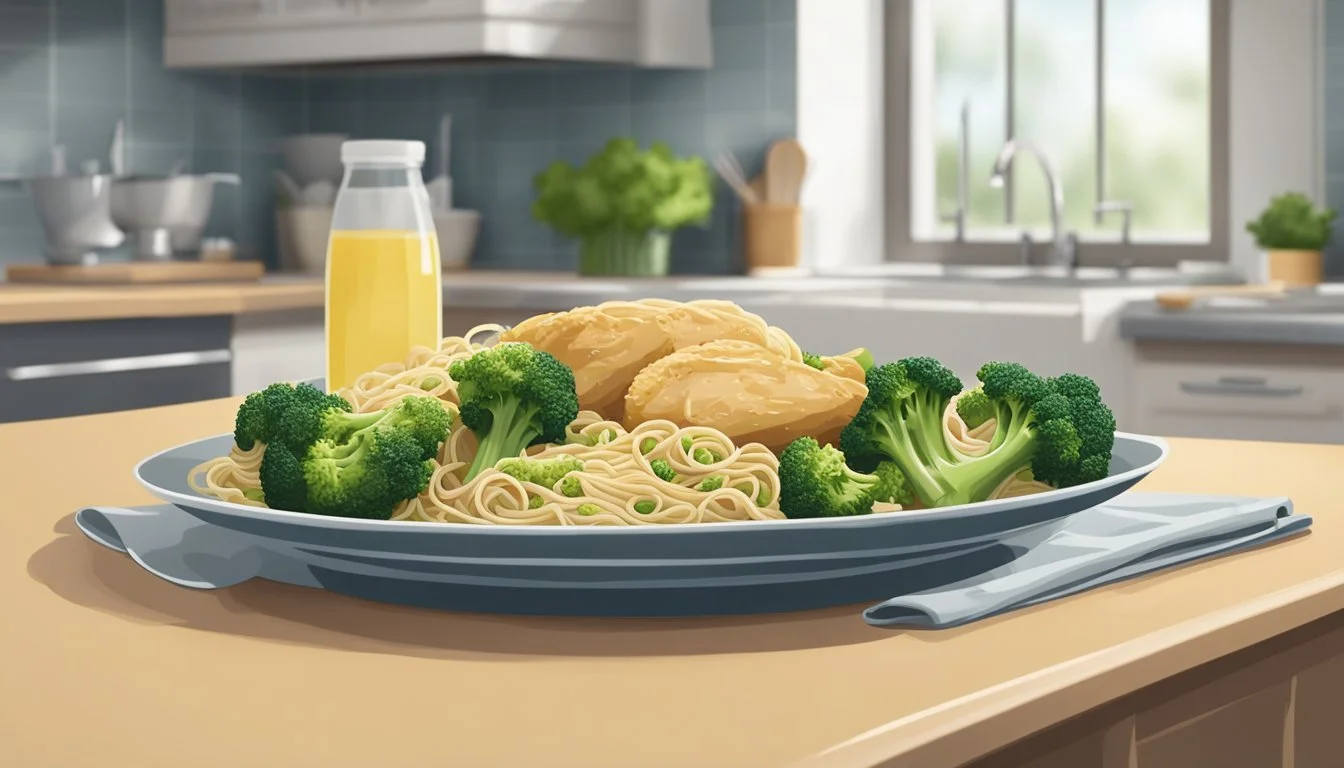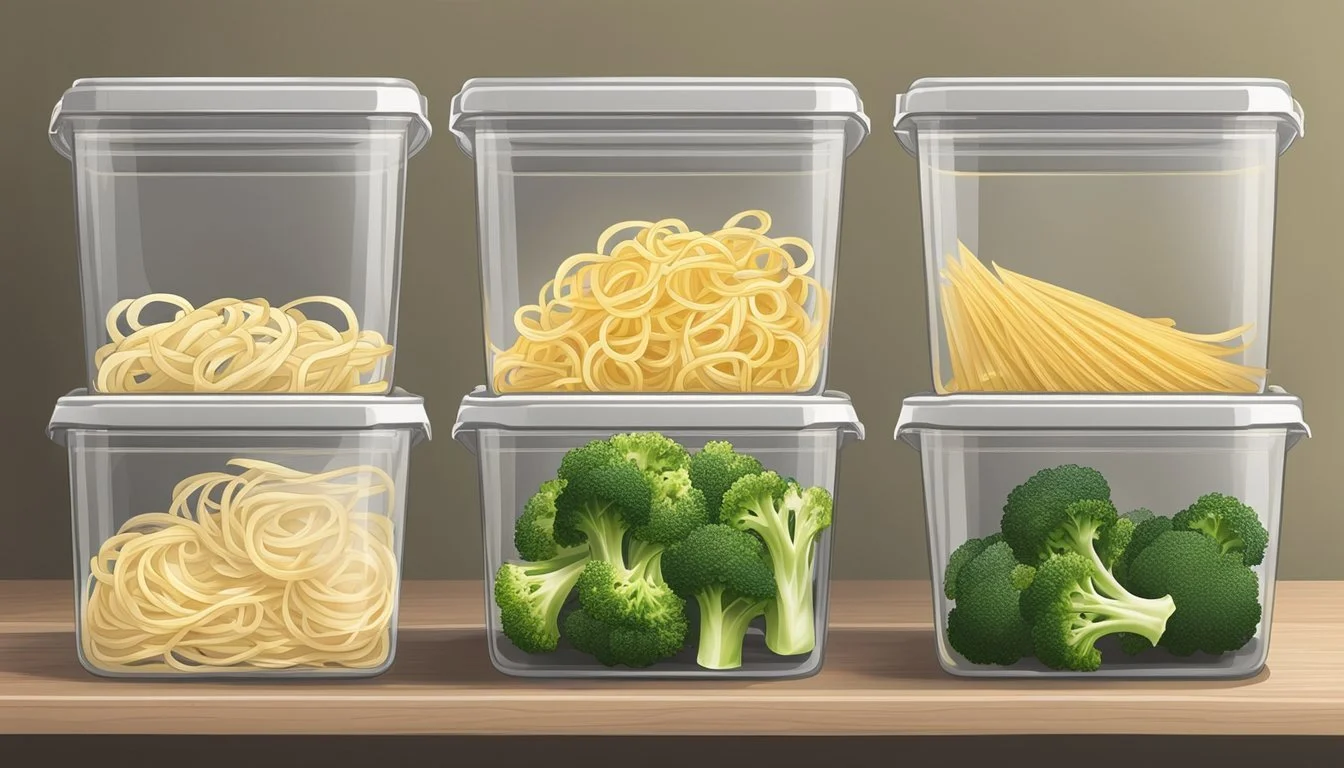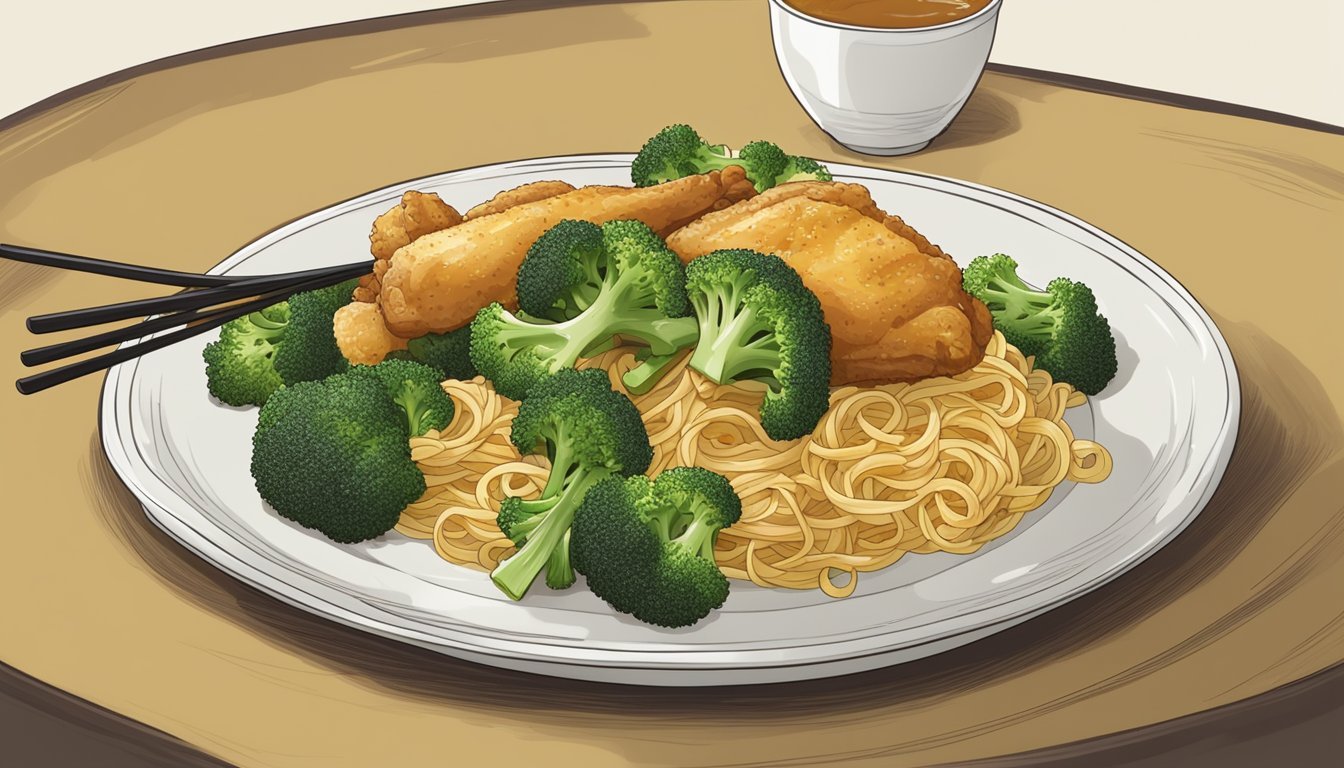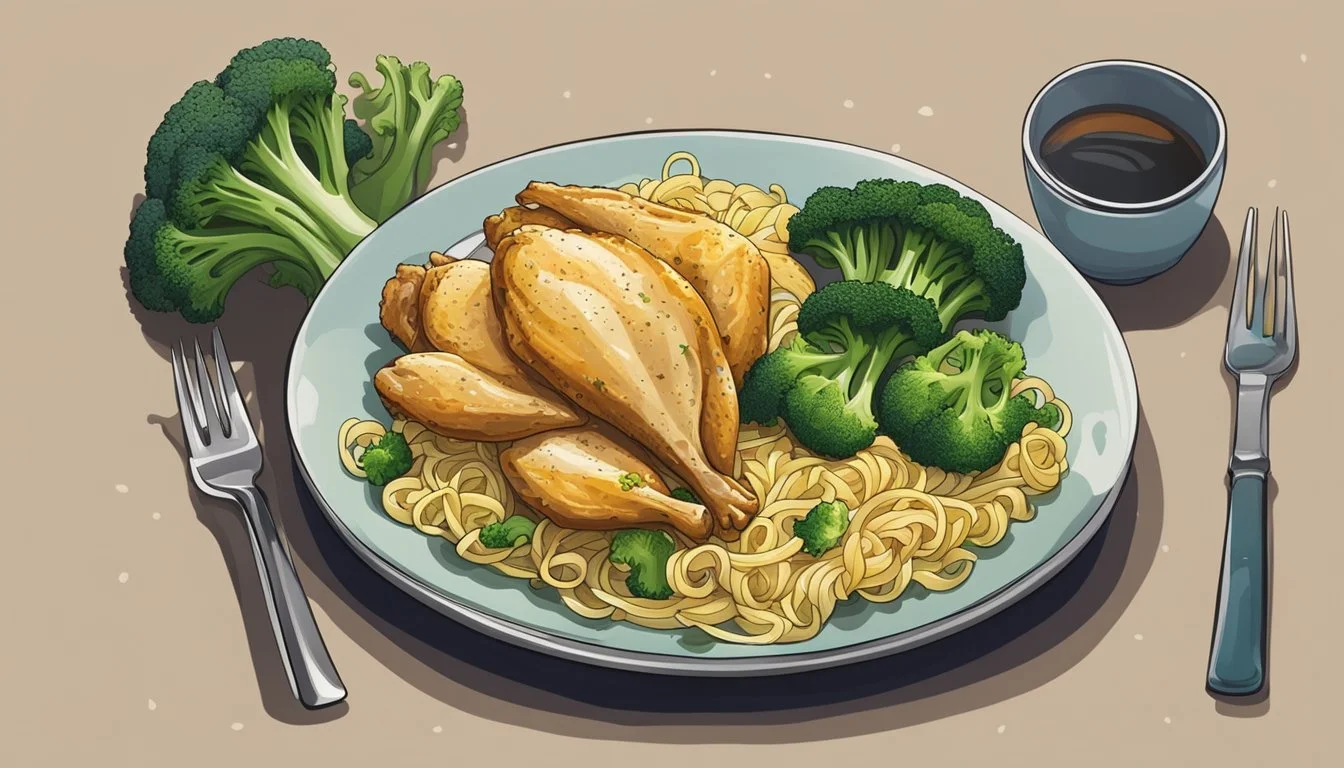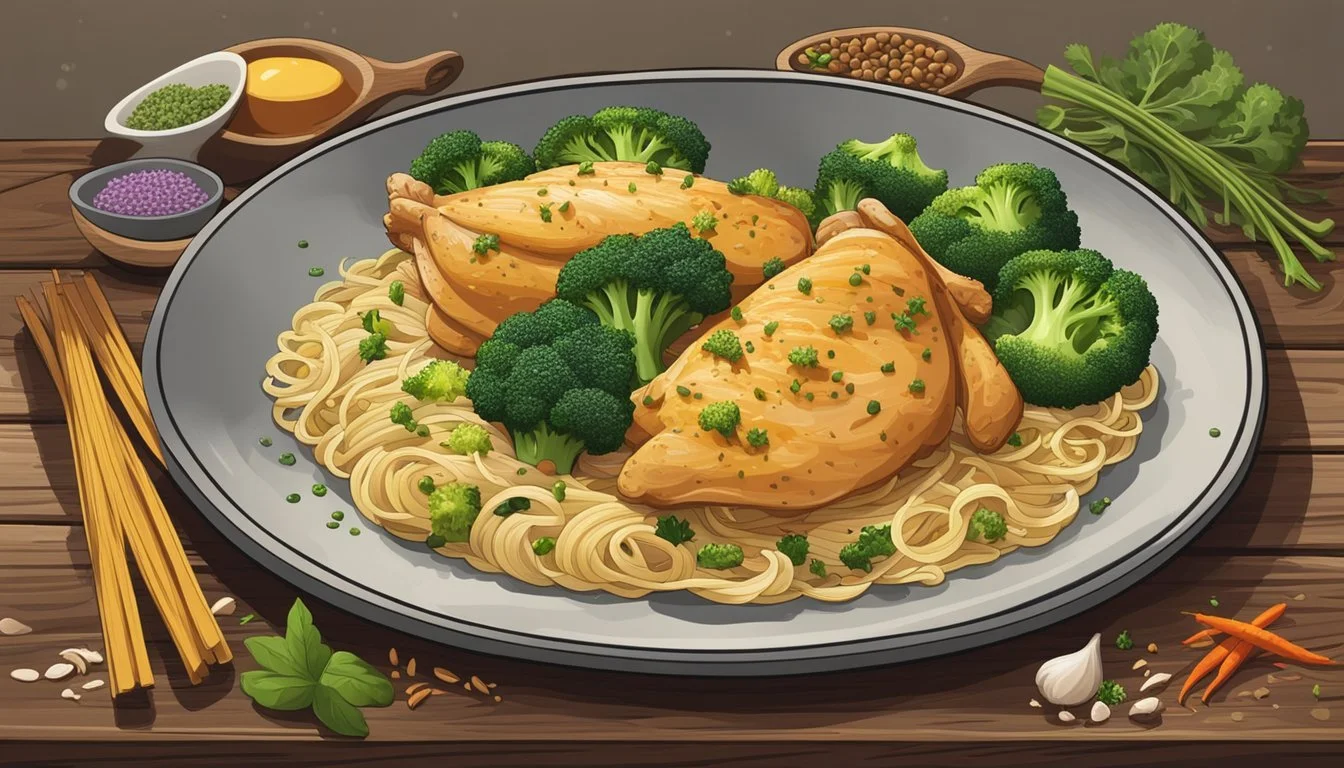How Long Does Chicken and Broccoli with Noodles Last?
Storage Tips and Shelf Life
Storing chicken and broccoli with noodles properly ensures that you can enjoy your meal safely for several days. These types of dishes can be kept in the refrigerator for about 3 to 4 days. For longer storage, freezing is an option and can extend the shelf life up to 2 to 3 months.
When storing leftovers in the refrigerator, use airtight containers to maintain freshness and prevent contamination. Make sure to reheat the dish thoroughly to an internal temperature of at least 165°F, ensuring it is safe to eat.
Keeping these simple guidelines in mind, you can prepare your meals in advance without worrying about waste. Enjoy the convenience of having delicious chicken and broccoli with noodles ready when you need it.
Understanding Food Safety
Managing the safety of your chicken and broccoli with noodles involves recognizing factors that affect shelf life and identifying signs of spoilage. Proper storage and keen attention to food quality help prevent health issues.
Factors Affecting Shelf Life
Temperature plays a crucial role. Cooked chicken, broccoli, and noodles should be stored in the fridge at 40°F (4°C) or lower. Freezing can extend the shelf life to several months, but texture and taste may be affected.
Using an airtight container reduces exposure to air and contaminants, slowing spoilage. Pantry storage is not suitable for these leftovers due to temperature and humidity variances.
Preparation method also matters. Ingredients mixed properly and promptly refrigerated last longer. Including sauces or dairy may shorten shelf life due to these ingredients' perishability.
Identifying Spoilage
Smell is a common indicator. A sour or rancid odor suggests bacterial growth. Discoloration and mold are visual signs of spoilage—avoid consuming any food showing these symptoms.
Texture changes, such as sliminess or an unusual firmness, usually mean the food is unsafe to eat. Check for separation in sauces or liquids, which may indicate the dish has gone bad.
Taste testing is not recommended as a primary method of identifying spoilage due to the risk of ingesting harmful bacteria. Always rely on visual and olfactory clues first.
Storage Practices for Leftovers
Proper storage of chicken and broccoli with noodles ensures that the meal remains safe and delicious for future consumption. Key factors include refrigerating cooked chicken promptly and properly, and knowing when freezing is the best option for extended shelf life.
Refrigerating Cooked Chicken
Refrigerate cooked chicken in an airtight container at 40°F or lower. This prevents bacteria growth and keeps the meal fresh.
Leftover chicken and broccoli with noodles should be stored within two hours after cooking. It's important to distribute the heat evenly within the fridge, so place the container in a central spot rather than the door. Pack leftovers in smaller portions to help them cool down faster.
Typically, cooked chicken can last in the fridge for 3 to 4 days. Label containers with dates to track how long they have been stored. Keeping a clean refrigerator environment also reduces the risk of cross-contamination.
Freezing for Extended Shelf Life
Freezing can significantly extend the life of leftovers. Store chicken, broccoli, and noodles in a freezer-safe airtight container.
When freezing, remove as much air as possible from the container to prevent freezer burn. It’s beneficial to portion the meal into single-serving containers or bags, which makes thawing convenient and reduces waste.
Frozen broccoli and cooked chicken can last up to 12 months in the freezer. While noodles may become softer when thawed, this can be minimized by undercooking them slightly before freezing.
Label each container with the date of freezing, and use older items first to maintain freshness.
Adhering to these practices helps ensure the safety and quality of your chicken and broccoli with noodles leftovers.
Chicken and Broccoli with Noodles Recipe Overview
This recipe offers a balanced meal featuring protein-rich chicken, nutritious broccoli, and satisfying noodles. It emphasizes freshness and simplicity to create a delicious and healthy dish.
Selecting Ingredients
Chicken: Opt for skinless chicken breasts for a lean source of protein. Alternatively, leftover chicken or rotisserie chicken can be used for convenience.
Broccoli: Fresh broccoli is ideal. Look for firm, bright green florets. Frozen broccoli is a viable alternative if fresh isn’t available.
Noodles: Options include egg noodles for their richness or udon noodles for a chewier texture. Choose according to preference and availability.
Seasonings and Sauces: Essential components include soy sauce, rice vinegar, honey, sesame oil, canola oil, and garlic. These contribute to the dish’s flavorful profile.
Preparation Techniques
Chicken Cooking Methods: Chicken can be either stir-fried, baked, or grilled. For stir-frying, cut the chicken into bite-sized pieces and cook until no longer pink. Ensure even cooking by stirring frequently.
Broccoli: Add the broccoli to boiling water for 3 minutes or steam it until tender-crisp. This helps maintain its vibrant color and nutritional value.
Noodles: Follow package instructions for boiling. Typically, they need to be cooked for about 6-7 minutes. Drain and run under cold water to prevent sticking.
Combining Ingredients: Heat olive oil in a large skillet, add the cooked chicken, broccoli, and noodles. Stir in the soy sauce mixture and toss until well combined. Season with salt and pepper to taste.
This straightforward preparation ensures that each component is cooked to perfection and well-seasoned, delivering a delightful culinary experience.
Cooking Methods for Chicken and Broccoli with Noodles
Various cooking methods can contribute to the flavor and dietary suitability of chicken and broccoli with noodles. Consider creating a balanced flavor profile and adjusting the recipe for dietary restrictions when preparing this dish.
Creating a Balanced Flavor Profile
To achieve a balanced flavor profile, focus on combining complementary ingredients like chicken broth, soy sauce, lemon juice, and garlic.
Start by sautéing garlic and ginger in a pot. Add chicken broth for depth, and incorporate soy sauce for umami.
Use lemon juice or rice vinegar for acidity. The key is balancing salty, sweet, sour, and spicy elements.
For noodles, cooking them until they are al dente helps maintain texture. Broccoli should be added toward the end to keep it crisp.
Adjusting for Dietary Restrictions
Adjustments can make the dish suitable for various dietary needs. For a gluten-free option, choose gluten-free pasta. This can seamlessly replace regular noodles without compromising taste. For those watching their sodium intake, consider low-sodium chicken broth and reduce soy sauce.
For a vegetarian rendition, substitute chicken with tofu. Saute your tofu until crispy to bring a texture that mirrors the chicken. Check all ingredients for potential allergens to ensure inclusivity for all dietary preferences and needs.
Serving Suggestions
Chicken and broccoli with noodles can be enhanced through thoughtful side dishes and appealing garnishes. These enhancements can elevate the dish from a simple meal to a well-rounded and visually appealing dining experience.
Complementary Side Dishes
Pairing chicken and broccoli with noodles with the right side dishes can create a balanced meal. Consider serving a crisp side salad with a light vinaigrette to add freshness.
Bread options like garlic bread or a crusty baguette can provide a satisfying contrast in texture. For those looking to add some heartiness, serving a cup of creamy soup or a small bowl of steamed rice on the side can be delightful.
Family dinners or weeknight dinners can be made more enjoyable by setting up a small salad bar with various toppings like shredded cheddar cheese, black pepper, and green onions, allowing everyone to personalize their sides.
Garnishing for Visual Appeal
Presentation can significantly enhance the dining experience. Garnishing chicken and broccoli with noodles not only adds flavor but also boosts visual appeal.
Green onions are a perfect garnish, adding a touch of color and a mild, fresh flavor. Sprinkle chopped parsley or cilantro for a more herbaceous note. A dash of freshly ground black pepper can provide a subtle spice and finish the look with a sophisticated touch.
Consider adding sesame seeds, especially if the dish includes Asian-inspired flavors. Finally, a sprinkle of shredded cheddar cheese can melt slightly over the hot noodles, adding both richness and a pop of color.
Health Benefits of Chicken and Broccoli with Noodles
Chicken and broccoli with noodles offer a nutritious, balanced meal. This dish combines lean protein, fiber-rich vegetables, and whole grains for a healthy option.
Nutritional Value
Chicken provides a high amount of lean protein which is essential for muscle repair and growth. A typical serving of chicken breast offers about 31 grams of protein and is relatively low in fat.
Broccoli, a cruciferous vegetable, delivers important vitamins such as vitamin C, K, and A. It also adds dietary fiber, which aids digestion and helps maintain a healthy gut.
Using whole grain pasta in the dish boosts fiber intake further. Whole grains are preferable over refined grains as they offer more nutrients and contribute to long-lasting energy levels.
Incorporating olive oil in the cooking process adds healthy fats. Olive oil is known for its heart-healthy properties and contains monounsaturated fats, which can help reduce bad cholesterol levels.
Weight Management
Chicken and broccoli with noodles can be an effective meal for weight management. Chicken is a lean source of protein, which helps in maintaining muscle mass while dieting. Protein also promotes a feeling of fullness, reducing overall calorie intake.
Broccoli is low in calories but high in fiber, which aids in promoting satiety. The fiber content in broccoli ensures that you feel full longer, thereby potentially reducing the temptation to snack between meals.
Proper portion control of whole grain pasta ensures that you benefit from the complex carbohydrates without overconsuming calories. Whole grain pasta has a lower glycemic index compared to refined pasta, leading to steady blood sugar levels.
With balanced portions of chicken, broccoli, and whole grain noodles, this dish supports a healthy diet conducive to weight management.
Alternative Variations of the Dish
Exploring different variations for chicken and broccoli noodles can suit various dietary needs and preferences. Here, we examine options for those seeking vegetarian or vegan alternatives and those needing low-carb or gluten-free options.
Vegetarian and Vegan Options
For a vegetarian or vegan twist, substituting tofu or tempeh for chicken can provide a rich source of protein. Marinate these alternatives in soy sauce, sesame oil, and rice vinegar for enhanced flavor.
Incorporating a variety of veggies such as bell peppers, carrots, and snap peas can add texture and nutrients.
For the sauce, opt for tamari instead of soy sauce to keep it gluten-free and include agave nectar as a honey substitute. For added creaminess, use coconut milk or a cashew-based sauce.
Low-Carb and Gluten-Free Adaptations
To make the dish low-carb and gluten-free, replace traditional pasta with zucchini noodles or spaghetti squash. These options significantly reduce carbohydrate intake while maintaining a satisfying texture.
For those with gluten sensitivities, gluten-free pasta or rice noodles can be used. Rice noodles absorb flavors well and keep the dish light.
Shrimp or steak are excellent substitutes for chicken in low-carb diets, offering a variety of flavors while adhering to dietary restrictions.
Adjusting the sauce with gluten-free soy sauce or tamari ensures the dish remains safe for those avoiding gluten.

